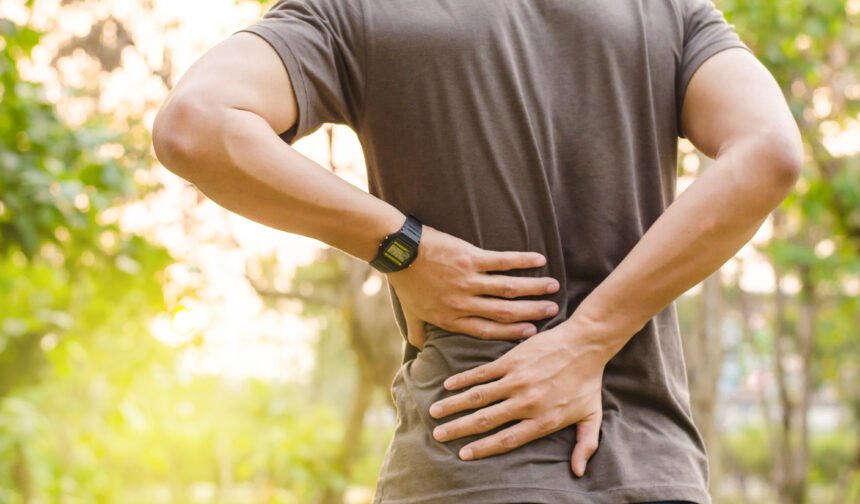The spine is one of the longest parts of the body and gives us a great deal of flexibility and strength. It’s made up of 33 vertebrae bones, one sitting on top of the other. In between these bones are discs and ligaments that are surrounded by muscles for support. The spinal cord passes through the vertebrae which protects it.
As you age, the joints, discs and ligaments in your spine also age and tend to get stiffer; this leads to back pain. That’s why it’s important to look after your back to reduce any risk of pain and injury as you get older.
The Common Issues
Back pain is one of the most common reasons that people miss work or go to the doctor. It’s also the leading cause of disability worldwide. Back pain can range from aching muscles to a shooting, stabbing or burning sensation. There are actually five common types of back pain to be aware of. Back pain can be localized to your back, or you may find it radiates down your legs. Movements like bending, lifting, walking or even standing may make your back pain worse.
“There are various symptoms that can arise as a result of lower back pain, and the severity can vary from mild to debilitating. You may find your symptoms get progressively worse or that they suddenly appear.”
To prevent back pain and back injuries in the future, it’s handy to know the most common issues so that you can prevent them. Elizabeth Gibbins and the other experts at Elms Chiropractic have shared some insights that will help you minimize the risk of back pain. Please keep reading to learn more.
Muscle Strain
Repeated heavy lifting in your job or a sudden awkward movement in day-to-day life can cause your back muscles and spinal ligaments to strain. The risk of straining your back through constant strain is increased if you aren’t in great physical condition. You need to take the appropriate steps to relieve muscle pain.
Ruptured Discs
The discs in your spinal cord act as cushions between the vertebrae, but the soft material inside the discs can bulge or rupture and press on a nerve which can cause severe back pain. Ruptured discs are most often the result of gradual, ageing-related wear and tear as the discs become less flexible and more prone to rupturing.
Osteoarthritis
In some cases, arthritis in the spine can lead to a narrowing of the space around the spinal cord which can affect the lower back.
Osteoporosis
Your spine’s vertebrae can develop painful fractures if your bones become porous. Osteoporosis causes bones to become less dense and fragile.
How You Can Help Back Pain
Back pain usually improves on its own within a few weeks. However, to speed up the healing process of back pain, there are a few things that you can do at home:
- Stay active. Staying in bed for long periods of time does minimise the stress on the back, but it can also create other problems including weakened muscles. It’s therefore important that you continue with your daily activities as much as you can.
- Take anti-inflammatories. Ibuprofen is a great anti-inflammatory that can relieve back pain by reducing the inflammation around your spine.
- Use an ice pack. Ice packs or frozen peas wrapped in a tea towel numbs sore tissues which provides pain relief similar to a local anaesthetic. Adding ice slows the nerve impulses in the area which interrupts the pain-spasm reaction.
- Add a heat pack. Heat therapy is an effective remedy for back pain as it boosts circulation which then allows nutrients and oxygen to travel to joints and muscles. This circulation helps repair damaged muscles, relieves inflammation and improves stiffness.
Tips On Looking After Your Back
Even though it’s hard to avoid common wear and tear on your back, making small changes now to your daily life may help to prevent severe damage in the future.
Strengthen Your Muscles
Increasing blood flow through exercise keeps the spine healthy and stretches your muscles. Going on daily walks is an easy and low-impact addition to slip into your day if heavier exercises aren’t for you. Another great way to strengthen your muscles around your back is to sit on an exercise ball intermittently for 20 to 30 minutes every day. Using the ball for stretches and exercises can help greatly.
Use The Right Chair
We’re all guilty of slouching in our office chairs, but did you know this is one of the leading causes of back pain? To prevent aches and pains in your back, invest in an ergonomic desk chair for your office which will help to align and support your back correctly. If you can’t afford to fork out for a special chair, you can place a rolled-up towel in the small of your back for additional support.
Lift With Care
Lifting is another common cause of back pain. Lifting heavy objects with your back bent is a one-way ticket to a bad back. To ensure you’re lifting with the proper technique, bend at your knees with a neutral spine, pivot your feet and hips rather than twisting your lower back and hold the object close to your chest while straightening your spine.

